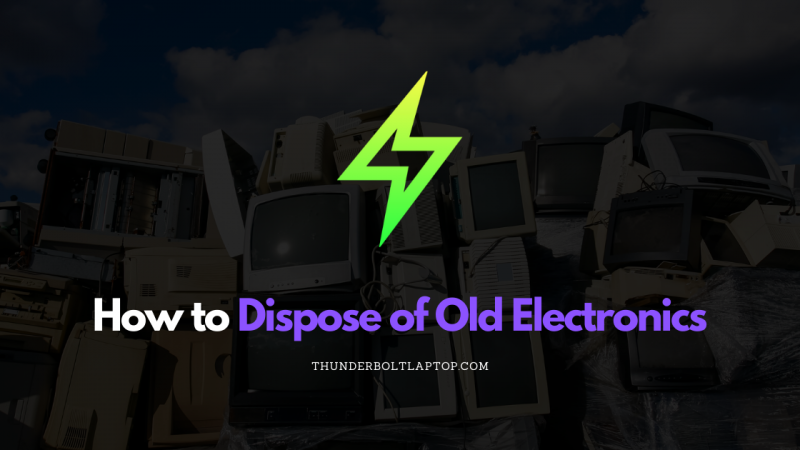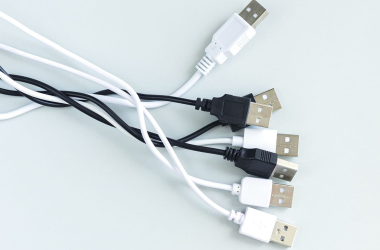In this article we’re presenting some smart and sustainable tactics to get rid of your old computers, phones, and other devices
In a world dominated by devices – from TVs, speakers, and display monitors to handheld devices such as laptops, mobile phones, and tablets up to wearable technology like smartwatches, there is also a problem that has been piling up, electronic waste.
Table of Contents
Frequent Replacement of Electronics
Electronics have a short useful life and transitions rapidly into e-waste. It is estimated that almost 500 million unused cell phones are sitting in people’s homes as of today. Annually, about 25% of the population get mobile phones while millions of electronic devices like TVs, computers, tablets reach the end of their useful life.
Even on the regular tech front, an average person has acquired a bit of accumulating gadgets while leaving out a game plan of electronic waste disposal.What Happens to Old Electronics
Electronic waste, or e-waste, is becoming a common issue in today’s landscape. According to a report by the United Nations, 44.7 million tons of e-waste was generated in 2016, an increase of 3.3 million metric tons (or 8%) from 2014. It’s expected to grow into 17% more with 52.2 million metrics tons of waste by 2021.
What’s disheartening is that many old electronics are still valuable and can be recycled, with the report from the UN suggesting that the world’s e-waste contains about $55 billion worth of recoverable materials.
Many of the materials used in electronics can be reused like plastics, metal, and glass.
Regrettably, toxic substances are also found on electronics that shouldn’t be sent to landfills. These toxins, when dumped away incorrectly, can leak into landfill, groundwater and can vaporize into the atmosphere – damaging yourself and the environment.
How to Dispose of Old Gadgets
Electronic waste is a serious problem. And disposal must be done carefully and responsibly.It’s time we talk about the ‘reduce, reuse, and recycle’ concept and fuse it into our habits as tech consumers.
There are various ways you can dispose of old electronics and not just the simple tossing it in a garbage bag and sending it away on garbage collection day.
1. Donate it
If your gadget still works, you can donate it away to various non-profit organizations.
There are plenty of charities and organizations out there that will be happy to take it off your hands. These organizations work with different partners around the world to donate used electronics to people who need it the most. Imagine getting rid of your old device while also making an impact on someone else’s life.
Here are a few organizations to help you get started:
- World Computer Exchange – Promotes the reuse and recycling of electronics. This organization provides used computers, laptops and many gadgets to communities around the world.
- Computers with Causes – A non-profit organization in the US, Computers with Causes refurbishes donated laptops or computers and gives to those who need education assistance, learning programs, foster homes, or even disabled veterans in need.
- AmericanCellPhoneDrive.org – Collects and refurbishes used cell phones intending to resell and recycle them in support of a variety of good causes.
- The Turing Trust – Located in the UK, The Turing Trust supports education in sub-Saharan Africa. The organization has enabled 41,000 students’ access to digital education, supported and trained of more than 500 teachers, and has reused more than 69 tons of waste.
- eBay for Charity – Allows you to sell your used devices and donate part of the proceeds to a charity of your choosing.
- National Cristina Foundation – Promotes technology reuse and helps donors of used laptops and computers to locate and select local charities or schools in their community to receive their donations.
2. Rent a dumpster
If you want to dispose of old electronics because you’re doing a major cleanout, try renting a dumpster to get rid of everything at once. It’s economical to do it because you can get rid of your e-waste and everything else you don’t need – even used furniture and other household junk, in one quick cleanup. You just sit back and relax and not worry about hauling stuff on a site.
You can choose a dumpster that fits your requirement and you get to choose how long you can keep stuff on-site. Although some dumpsters don’t allow electronics or require a processing fee, it’s worth checking out so make sure you call your local dumpster to know more.
You can check out these service providers to learn more about dumpster renting:
- Dumpsters.com – Offers dumpster rental service to over 250 cities in the U.S. and caters to residential and commercial dumpster requirements. You can directly ask for a quote on their website by entering your city location.
- Junk King – A dumpster rental service that operates mostly in North America with 100 locally-owned franchises. Junk King takes just about anything – from furniture to construction waste to even e-waste. They also reuse, recycle, and donate 60% of their haul because they commit to an eco-friendly service.
- Budget Dumpster – Established in 2009, Budget Dumpster is in over 150 cities in the U.S and offers dumpster rental in various sizes fit for all types of waste removal requirements. Check their website to know rental prices in your area.
If you’re planning to rent a dumpster, make sure you communicate your requirements well with the service provider to make sure everything is covered.
3. Check out your local hazardous waste facility
Try checking out your local hazardous waste facility if you don’t have enough electronics to dispose of to rent a dumpster. This facility will safely disassemble your devices for disposal.
Finding a local waste facility to take care of your e-waste is a low-cost disposal option that is useful in throwing away small amounts of electronics. The downside is that collection may be limited to certain items and you may have to deliver the equipment to the facility’s location.
Although these facilities operate at both the city and the country level, it might not be available in your area. You can try reaching out to your city’s public works department to know if there’s one near you.
You can also use the Resource Conservation and Recovery Act Information (RCRAInfo) website to search and determine specific hazardous waste handlers. You can find wide information on treatment, storage, and disposal facilities on their website.
4. Bring it to a recycler
There are plenty of non-profit organizations that offer to recycle old electronics. Cities and towns sometimes even sponsor the collection of electronics to be recycled.
Call2Recycle is a non-profit organization that collects and recycles batteries intending to keep them out of landfills. They operate across North America and offer convenient drop-off locations including The Home Depot, Lowe’s, and Staples.
If you want to find reuse, recycling, and donation programs in your location, you can head over to the TIA E-cycling Central website to check out these events. You can also find tons of information on their website to help you know more about electronics recycling events.
Earth911 contains 100,000+ listings of extensive recycling databases in North America. You can use their website to find a center nearest you that accepts used electronics.
Alternatively, you can visit e-Stewards if you want to learn more about principled and practical standards for electronics recycling and reuse. Sustainable Electronics Recycling International (SERI) is also a good avenue of learning about responsible e-waste management. SERI can also assist you in finding a recycler in your area with its vast directory spanning across the globe.
The EERA (European Electronics Recyclers Association) EERA is a professional association for reuse, recycling, and reprocessing in Europe dealing with electrical and electronic waste equipment.
If you’re in Canada and looking for a recycler of your electronics, you can check out EPRA (Electronic Products Recycling Association).
5. Reach out to a tech firm
Some of them include:
- Best Buy – Best Buy accepts all kinds of used tech from residents, regardless of where you bought it or how old it is. They recycle products for free and can accept up to three items per household per day and can include TVs, computers, applications, cell phones, printers, etc.
- Apple – Apple’s GiveBack program offers up to $1,000 gift cards or in-store credit for certain devices. You can get credit for your purchase and if your device doesn’t qualify, Apple will freely recycle your device for free.
- Staples – Offers tech trade-in for smartphones, tablets, and laptops. You can also bring in old and broken electronics and they’ll recycle it for you for free.
- Dell – Provides convenient recycling solutions from old computers to game consoles and ink cartridges with permanent drop-off site, main-in and event recycling options.
- Sprint – Sprint’s Buyback program offers credits to up to $300 for mobile phones from any carrier.
- Sony – Sony’s Take Back Recycling Program with ERI has dropped off locations, events, and haul away recycling options at no cost.
- HP – Offers free and convenient ways to recycle used Original HP ink and toner cartridges, LaserJet maintenance parts and supplies, and Samsung toner cartridges
You can also check in with your employer to know how they handle e-waste. You may be able to add a few more items to the collection.
6. Sell your old gadgets
If your electronics are still working and valuable and you don’t want to donate or recycle them, sell them instead of throwing them away. There are many sites like Craigslist, Facebook Marketplace, and eBay to listing them instead of sending them straight to landfills.
Why Donate, Reuse, or Recycle Old Electronics?There are ways of getting rid of old electronics. But why practice donating, reusing, and recycling?
According to the Environmental Protection Agency (EPA), donating or recycling conserves our natural resources and helps avoid air and water pollution as well as greenhouse emissions. Did you know that recycling one million laptops can save energy that is equivalent to the electricity used by more than 3,500 US homes in a year? And for every one million cell phones recycled, there is 35 thousand pounds of copper, 772 pounds of silver, 75 pounds of gold, and 33 pounds of palladium that is recovered.
E-waste may look different on the single-use plastic waste, but the impact can be just as devastating. And ways on how to mindfully dispose of e-waste can be just as helpful.
Sustainable Disposal
With the rate of technology advancing every single day, buying new electronics is inevitable. But make sure that each time you replace your old device, it’s your responsibility to make sure your old gadgets get disposed of properly.
And if you’re aiming to be sustainable, it’s ideal to consume less. If you can, try not to get pulled into the hype of new technology. But if your product has reached its useful service life, it’s your responsibility to dispose of them properly.
It’s time to be a part of the solution.
We love technology. But we also love our planet. And so, while we move forward with technology, let’s not forget to take care of our planet by responsibly disposing of our old electronics. We’re not only helping others by donating our used gadgets or helping ourselves get rid of e-waste by bringing it to a recycler, but we’re also helping the planet.
Let’s move forward with technology sustainably.
Additional Tips Before You Dispose of Old Electronics:- Before buying a new computer or laptop, consider upgrading your hardware or software instead of getting a new one.
- Make sure to erase all personal information on your device. For computers, wipe your hard drive clean. It isn’t as simple as deleting files so make sure you follow these steps. For mobile phones, you can use and follow this guide.
- For electronics containing rechargeable batteries, remove the batteries and recycle them separately.





